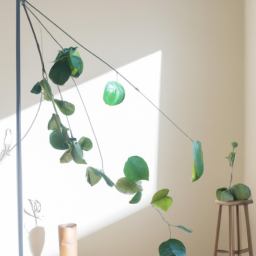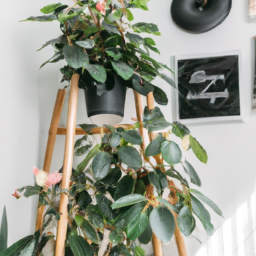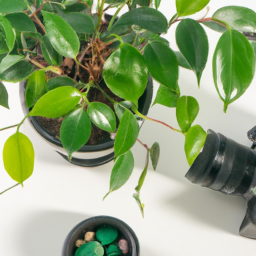
Are you looking to add some greenery to your home but not sure where to hang indoor plants? You’re in the right place! Indoor plants are a great way to bring life and color to any room, and hanging them can create a beautiful and unique display. In this blog post, we’ll explore different areas in your home where you can hang indoor plants to enhance your space and improve air quality. Let’s dive in and discover the perfect spots for your leafy friends to thrive!
Benefits of Hanging Indoor Plants
Indoor plants not only add a touch of greenery to your home but also come with numerous benefits for your health and well-being. Hanging indoor plants can be a great way to maximize space and create a unique and stylish look in your living space. Here are some of the benefits of hanging indoor plants:
Improved Air Quality
One of the main benefits of hanging indoor plants is their ability to improve air quality. Plants absorb carbon dioxide and release oxygen through the process of photosynthesis, which can help to purify the air in your home. Hanging plants can also help to remove toxins and pollutants from the air, creating a healthier indoor environment for you and your family.
In addition to purifying the air, indoor plants can also help to increase humidity levels in your home. This can be especially beneficial during the winter months when indoor heating can dry out the air. Hanging plants can help to maintain optimal humidity levels, which can prevent respiratory problems and improve overall well-being.
Some of the best plants for improving air quality include spider plants, pothos, and peace lilies. These plants are easy to care for and can thrive in a variety of indoor environments.
Stress Reduction
Research has shown that spending time around plants can help to reduce stress and anxiety levels. The presence of greenery has a calming effect on the mind and can help to create a sense of tranquility in your home. Hanging indoor plants can be especially effective at promoting relaxation, as they can create a peaceful and serene atmosphere in any room.
In addition to reducing stress, indoor plants can also help to improve concentration and productivity. Studies have shown that having plants in your workspace can help to boost creativity and focus, making you more efficient and effective in your daily tasks.
Some of the best plants for promoting relaxation include lavender, jasmine, and aloe vera. These plants have soothing scents and can help to create a spa-like atmosphere in your home.
Aesthetic Appeal
Aside from their health benefits, hanging indoor plants can also enhance the aesthetic appeal of your home. Plants can add a pop of color and texture to any room, creating a visually appealing and inviting space. Hanging plants can be a great way to add dimension and interest to your decor, whether you choose to hang them from the ceiling, wall, or window.
When choosing plants for aesthetic purposes, consider the size, shape, and color of the plant in relation to your existing decor. You can also mix and match different types of plants to create a unique and personalized look that reflects your style and personality.
Some popular hanging plants for aesthetic appeal include string of pearls, Boston fern, and English ivy. These plants have cascading foliage that can add a touch of elegance and charm to any room.

Best Locations for Hanging Indoor Plants
Choosing the Right Spot
When it comes to hanging indoor plants, the first step is to choose the right spot. Consider the lighting conditions in your home – some plants thrive in bright, direct sunlight, while others prefer indirect light. Make sure to also take into account the humidity levels in the room, as some plants require more moisture than others.
One popular spot for hanging indoor plants is near a window. This allows the plants to get plenty of natural light, which is essential for their growth. However, be mindful of any drafts that may come through the window, as this can be harmful to certain plants. If you have limited natural light in your home, you can also consider using grow lights to supplement the light for your plants.
Another great location for hanging indoor plants is in the bathroom. The high humidity levels in the bathroom create the perfect environment for many plants, such as ferns and orchids. Just make sure that the plants are not directly in the path of the shower or bath, as the water can be too harsh for them.
Consider the Size and Weight of the Plant
Before hanging your indoor plants, it’s important to consider the size and weight of the plant. Some plants, like pothos and spider plants, are lightweight and can be hung from a simple hook or nail. However, larger plants, such as fiddle leaf figs or monstera, may require a more sturdy hanging mechanism, like a ceiling hook or plant hanger.
When choosing a location for your plants, make sure that the structure can support the weight of the plant. Hanging plants from a weak or flimsy surface can be dangerous, as the plant may fall and cause damage or injury. If you’re unsure about the weight capacity of a certain area, it’s best to consult with a professional or use a plant stand instead.
Additionally, consider the size of the plant in relation to the space where you want to hang it. You don’t want the plant to overwhelm the room or obstruct any walkways. Hanging plants at different heights can create a visually appealing display and add depth to the room.
Creating a Stylish Display
Once you’ve chosen the right spot and considered the size and weight of the plant, it’s time to create a stylish display. Mixing and matching different types of plants can add visual interest and texture to a room. Consider hanging plants with varying leaf shapes, sizes, and colors to create a dynamic and eye-catching display.
You can also get creative with the containers you use to hang your plants. Macrame plant hangers, decorative hooks, and hanging baskets are all great options for adding a touch of style to your indoor plant display. Consider the overall aesthetic of the room and choose containers that complement the decor.
Don’t be afraid to experiment with different arrangements and placements until you find the perfect setup for your indoor plants. Remember to regularly water and care for your plants to ensure they thrive in their new hanging environment.

DIY Hanging Planters for Indoor Plants
Welcome to our guide on creating your own DIY hanging planters for indoor plants. Hanging planters are a great way to add greenery to your space while saving valuable floor space. In this article, we will discuss various creative and budget-friendly ways to hang your indoor plants.
Macrame Plant Hangers
Macrame plant hangers are a trendy and stylish way to display your indoor plants. To make your own macrame plant hanger, you will need some macrame cord, a metal ring, and a pot to hold your plant. Start by cutting several pieces of macrame cord to your desired length, then attach them to the metal ring using basic macrame knots.
Once you have created the hanger, simply place your pot inside and hang it from a hook in your ceiling. Macrame plant hangers can be customized with different colored cords and knots to match your decor style.
These hangers are perfect for trailing plants like pothos or spider plants, as they allow the vines to cascade down elegantly. They also work well for smaller pots that can be hung in a group for a stunning visual display.
Repurposed Items
Another creative way to hang your indoor plants is by repurposing items you already have at home. For example, you can use old mason jars, tin cans, or even wooden crates to create unique hanging planters.
To make a hanging planter out of a mason jar, simply drill a hole in the lid for drainage, add some pebbles or activated charcoal at the bottom for drainage, and then plant your favorite indoor plant. Attach a piece of twine or rope to the jar and hang it from a hook in your ceiling or on a wall hook.
Repurposed hanging planters add a touch of rustic charm to your space and are a great way to upcycle old items that would otherwise be thrown away. Get creative and see what unique hanging planters you can come up with!
Wall-Mounted Planters
If you’re short on floor space, consider creating wall-mounted planters for your indoor plants. Wall-mounted planters can be made from wood, metal, or even fabric pockets, and are a great way to add greenery to your walls.
To make a wall-mounted planter, simply attach a planter box or pocket to your wall using screws or hooks. Fill the planter with soil and plant your favorite indoor plants. Wall-mounted planters are perfect for herbs, succulents, or small trailing plants.
Get creative with your wall-mounted planters by arranging them in a geometric pattern or creating a living wall with multiple planters. Not only do wall-mounted planters save space, but they also add a unique and eye-catching element to your decor.
Here’s what we learned
When it comes to adding some greenery to your home, indoor plants are the perfect solution. Not only do they add a touch of nature to your space, but they also have numerous health benefits. But the question remains, where is the best place to hang indoor plants in your home?
One popular spot to hang indoor plants is near windows. Most indoor plants thrive in natural light, so hanging them near windows allows them to soak up the sunlight they need to grow and thrive. Another great place to hang indoor plants is in the bathroom. The humidity from showers and baths provides the perfect environment for many plants to flourish. Additionally, hanging plants in the bathroom can help purify the air and add a touch of spa-like relaxation to the space. Ultimately, the best place to hang indoor plants will depend on the specific needs of the plants you have and the layout of your home. So get creative and experiment with different locations to find the perfect spot for your indoor greenery.
Here are some FAQs you’d be interested in:
Q1. What are the best locations to hang indoor plants?
A1. The best locations to hang indoor plants are near windows where they can receive adequate sunlight, in corners of rooms to add a touch of greenery, or in areas with high humidity like bathrooms.
Q2. Can indoor plants be hung from the ceiling?
A2. Yes, indoor plants can be hung from the ceiling using hooks or macrame plant hangers. This is a great way to add visual interest and save space in your home.
Q3. How do I choose the right indoor plants to hang?
A3. When choosing indoor plants to hang, consider the amount of light they need, the size of the plant, and your personal style preferences. Some popular hanging plants include pothos, spider plants, and philodendrons.
Q4. What are some creative ways to hang indoor plants?
A4. Some creative ways to hang indoor plants include using a ladder plant stand, hanging plant shelves, or creating a DIY macrame plant hanger. Get creative and let your personal style shine!
Q5. How do I care for indoor plants that are hung?
A5. When caring for indoor plants that are hung, be sure to water them regularly, rotate them occasionally to ensure even growth, and dust the leaves to keep them clean. Pay attention to their specific care requirements to keep them thriving.
Dr. Olivia Green is a botanist with over two decades of experience in indoor plant cultivation. She holds a Ph.D. in Plant Biology and has dedicated her career to researching plant behavior in controlled environments. Dr. Green is passionate about helping plant enthusiasts master the art of indoor gardening through her extensive knowledge and practical insights.


